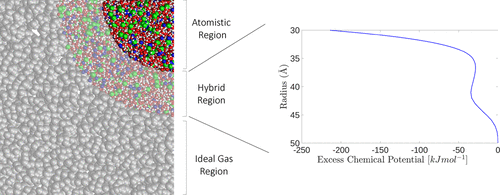当前位置:
X-MOL 学术
›
J. Chem. Theory Comput.
›
论文详情
Our official English website, www.x-mol.net, welcomes your feedback! (Note: you will need to create a separate account there.)
Spatially Resolved Thermodynamic Integration: An Efficient Method To Compute Chemical Potentials of Dense Fluids
Journal of Chemical Theory and Computation ( IF 5.5 ) Pub Date : 2018-06-06 00:00:00 , DOI: 10.1021/acs.jctc.8b00002 Maziar Heidari 1 , Kurt Kremer 1 , Robinson Cortes-Huerto 1 , Raffaello Potestio 1, 2, 3
Journal of Chemical Theory and Computation ( IF 5.5 ) Pub Date : 2018-06-06 00:00:00 , DOI: 10.1021/acs.jctc.8b00002 Maziar Heidari 1 , Kurt Kremer 1 , Robinson Cortes-Huerto 1 , Raffaello Potestio 1, 2, 3
Affiliation

|
Many popular methods for the calculation of chemical potentials rely on the insertion of test particles into the target system. In the case of liquids and liquid mixtures, this procedure increases in difficulty upon increasing density or concentration, and the use of sophisticated enhanced sampling techniques becomes inevitable. In this work, we propose an alternative strategy, spatially resolved thermodynamic integration, or SPARTIAN for short. Here, molecules are described with atomistic resolution in a simulation subregion and as ideal gas particles in a larger reservoir. All molecules are free to diffuse between subdomains adapting their resolution on the fly. To enforce a uniform density profile across the simulation box, a single-molecule external potential is computed, applied, and identified with the difference in chemical potential between the two resolutions. Since the reservoir is represented as an ideal gas bath, this difference exactly amounts to the excess chemical potential of the target system. The present approach surpasses the high density/concentration limitation of particle insertion methods because the ideal gas molecules entering the target system region spontaneously adapt to the local environment. The ideal gas representation contributes negligibly to the computational cost of the simulation, thus allowing one to make use of large reservoirs at minimal expenses. The method has been validated by computing excess chemical potentials for pure Lennard-Jones liquids and mixtures, SPC and SPC/E liquid water, and aqueous solutions of sodium chloride. The reported results well reproduce literature data for these systems.
中文翻译:

空间分辨热力学积分:一种计算稠密流体化学势的有效方法
用于计算化学势的许多流行方法都依赖于将测试颗粒插入目标系统中。在液体和液体混合物的情况下,随着密度或浓度的增加,该过程的难度增加,并且不可避免地会使用复杂的增强采样技术。在这项工作中,我们提出了一种替代策略,即空间解析热力学积分,或简称SPARTIAN。在此,在模拟子区域中以原子分辨率描述分子,并在较大的储层中将其描述为理想的气体粒子。所有分子都可以自由散布在子域之间,从而动态调整其分辨率。为了在整个模拟框内实现均匀的密度分布,需要计算,施加单分子外部电势,并确定了两种分辨率之间化学势的差异。由于储层被表示为理想的气浴,因此该差异恰好等于目标系统的过量化学势。由于理想的气体分子自发地进入目标系统区域,因此本方法超越了粒子插入方法的高密度/浓度限制。理想的气体表示量对模拟的计算成本的贡献可忽略不计,因此使人们能够以最小的费用使用大型储层。该方法已通过计算纯Lennard-Jones液体和混合物,SPC和SPC / E液态水以及氯化钠水溶液的过量化学势进行了验证。
更新日期:2018-06-06
中文翻译:

空间分辨热力学积分:一种计算稠密流体化学势的有效方法
用于计算化学势的许多流行方法都依赖于将测试颗粒插入目标系统中。在液体和液体混合物的情况下,随着密度或浓度的增加,该过程的难度增加,并且不可避免地会使用复杂的增强采样技术。在这项工作中,我们提出了一种替代策略,即空间解析热力学积分,或简称SPARTIAN。在此,在模拟子区域中以原子分辨率描述分子,并在较大的储层中将其描述为理想的气体粒子。所有分子都可以自由散布在子域之间,从而动态调整其分辨率。为了在整个模拟框内实现均匀的密度分布,需要计算,施加单分子外部电势,并确定了两种分辨率之间化学势的差异。由于储层被表示为理想的气浴,因此该差异恰好等于目标系统的过量化学势。由于理想的气体分子自发地进入目标系统区域,因此本方法超越了粒子插入方法的高密度/浓度限制。理想的气体表示量对模拟的计算成本的贡献可忽略不计,因此使人们能够以最小的费用使用大型储层。该方法已通过计算纯Lennard-Jones液体和混合物,SPC和SPC / E液态水以及氯化钠水溶液的过量化学势进行了验证。



























 京公网安备 11010802027423号
京公网安备 11010802027423号